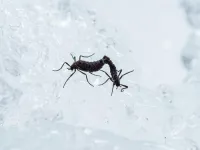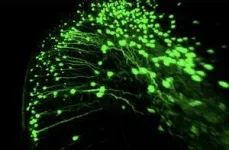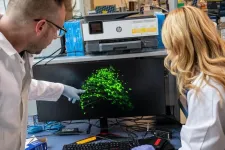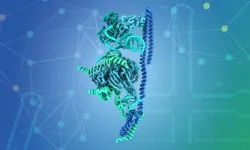Antarctica’s only native insect’s unique survival mechanism
Antarctic midge 1st reported organism using both quiescence and obligate diapause in multiple overwintering
2025-02-12
(Press-News.org)
Picture an Antarctic animal and most people think of penguins, but there is a flightless midge, the only known insect native to Antarctica, that somehow survives the extreme climate. How the Antarctic midge (Belgica antarctica) copes with freezing temperatures could hold clues for humans about subjects like cryopreservation, but there remain many mysteries about the tiny insect.
One mystery appears to have been solved by an Osaka Metropolitan University-led international research team. Graduate School of Science Professor Shin G. Goto and Dr. Mizuki Yoshida, a graduate student at the time of the research who is now a postdoc at Ohio State University, found that the midge deals with the seasons during its two-year life cycle by undergoing quiescence in its first year and obligate diapause in its second.
Quiescence is a form of dormancy in immediate response to adverse conditions, and when conditions improve, the organism becomes active again. Obligate diapause is a dormant period naturally induced at a fixed time in an organism’s life cycle, a rare form seen in insects in temperate regions.
“We were able to establish a method for rearing the Antarctic midge over a period of six years to find out some of their environmental adaptation mechanisms,” Dr. Yoshida explained.
The team found that Antarctic midge larvae usually grow to their second instar by the first winter and undergo quiescence so that they can quickly resume development at any moment when it suddenly becomes warmer. As the second winter approaches, the larvae reach the final fourth instar, but they do not pupate. Instead, they enter obligate diapause so that they all emerge as adults when summer arrives. As adults, they have only a few days of life and need to find a mate, so this timing mechanism is key to their survival.
“We determined that for the Antarctic midge obligate diapause ends with the onset of low temperatures in winter so that the larvae all pupate at the same time and emerge as adults at the same time,” Professor Goto stated. “Although seasonal adaptation strategies involving overwintering multiple times using both quiescence and obligate diapause have not been reported in other organisms, we believe that insects inhabiting harsh environments such as the Arctic and high altitudes might be employing similar strategies.”
###
About OMU
Established in Osaka as one of the largest public universities in Japan, Osaka Metropolitan University is committed to shaping the future of society through “Convergence of Knowledge” and the promotion of world-class research. For more research news, visit https://www.omu.ac.jp/en/ and follow us on social media: X, Facebook, Instagram, LinkedIn.
END
[Attachments] See images for this press release:


ELSE PRESS RELEASES FROM THIS DATE:
2025-02-12
A new study explores how complex chemical mixtures change under shifting environmental conditions, shedding light on the prebiotic processes that may have led to life. By exposing organic molecules to repeated wet-dry cycles, researchers observed continuous transformation, selective organization, and synchronized population dynamics. Their findings suggest that environmental factors played a key role in shaping the molecular complexity needed for life to emerge. To simulate early Earth, the team subjected chemical mixtures to repeated wet-dry cycles. Rather than reacting randomly, the molecules organized themselves, evolved over time, and followed predictable patterns. This challenges ...
2025-02-12
Global aviation carbon dioxide emissions increased by 1% in 2023 because planes had to fly longer routes to avoid Russian airspace, according to a new study.
After Russia invaded Ukraine in February 2022, Western airlines were banned from flying over Russia. This forced them to take much longer routes between Europe or North America and East Asia, burning more fuel in the process.
Published today (Wednesday, 12 February) in Communications Earth & Environment, the study found that detours caused by the Ukraine war led to planes using 13% more fuel on average compared to their original routes. The impact was even greater for flights between Europe and Asia, which saw a 14.8% increase in ...
2025-02-12
For the first time, scientists have demonstrated that negative refraction can be achieved using atomic arrays - without the need for artificially manufactured metamaterials.
Scientists have long sought to control light in ways that appear to defy the laws of Nature.
Negative refraction - a phenomenon where light bends in the opposite direction to its usual behaviour - has captivated researchers for its potential to revolutionise optics, enabling transformative technologies such as superlenses and cloaking devices.
Now, carefully ...
2025-02-12
Research Highlights:
A data analysis projected that South Asian adults living in the United Kingdom may experience elevated blood pressure nine years earlier than East Asian adults on average.
The largest blood pressure disparities between South Asian and East Asian adults were projected to be in 18-39-year-old men and 40–64-year-old women.
The projected increase in systolic blood pressure in middle age East Asian adults was linked to a nearly 2.5 times higher risk for heart disease caused by blocked arteries and a nearly fourfold greater risk of stroke. Even at an older age, high systolic ...
2025-02-12
Take a look around your home and you’ll find yourself surrounded by familiar comforts—photos of family and friends on the wall, well-worn sneakers by the door, a shelf adorned with travel mementos.
Objects like these are etched into our memory, shaping who we are and helping us navigate environments and daily life with ease. But how do these memories form? And what if we could stop them from slipping away under a devastating condition like Alzheimer’s disease?
Scientists at UBC’s faculty of medicine have ...
2025-02-12
Australian scientists have found an effective new way to clean up methylmercury, one of the world’s most dangerous pollutants, which often builds up in our food and environment because of industrial activities such as illegal gold mining and burning coal. The discovery, published in Nature Communications on 12 February 2025, could lead to new ways of engineering animals to protect both wildlife and human health.
The research team from Macquarie University's Applied BioSciences, CSIRO, Macquarie Medical School, and the ARC Centre of Excellence in Synthetic Biology, has successfully genetically modified fruit flies and zebrafish to transform methylmercury into a ...
2025-02-12
New study reveals that coral reefs in the Gulf of Eilat experienced a surprising 3,000-year "shutdown" in growth, from about 4,400 to 1,000 years ago, likely due to a temporary drop in sea level that could have been caused by global cooling. This phenomenon, which aligns with similar reef interruptions in Mexico, Brazil, and Australia, suggests a widespread environmental shift during that period. Despite the long pause, the reef eventually recovered, with coral species reappearing from deeper ...
2025-02-12
A new study has revealed the clearest-ever picture of the surface chemistry of worm species that provides groundbreaking insights into how animals interact with their environment and each other. These discoveries could pave the way for strategies to deepen our understanding of evolutionary adaptations, refine behavioural research, and ultimately overcome parasitic infections.
Scientists from the University’s School of Pharmacy used an advanced mass spectrometry imaging system to examine the nematodes Caenorhabditis elegans and Pristionchus pacificus, aiming to characterise species-specific surface chemical ...
2025-02-12
In human cells, only a small proportion of the information written in genes is used to produce proteins. How does the cell select this information? A large molecular machine called the spliceosome continuously separates the coding and non-coding regions of our genes – and it's doing this even as you read these lines.
The spliceosome is critical for the proper functioning of every cell, and numerous genetic disorders are linked to problems with spliceosome function. In most eukaryotic cells, two types of ...
2025-02-12
Glaciers, sediments, and pollen can be used to reconstruct the climate of the past. Beyond ‘nature’s archive,’, other sources, such as diaries, travel notes, parish or monastery registers, and other written documents – known at the ‘society’s archive’ – contain reports and observations about local climates in bygone centuries.
In contrast, the second half of the century was characterized by heavy rainfall and floods, particularly in the 1590s.
The western parts of the European continent cooled significantly when in the 16th century a period known as the ‘Little Ice Age’ intensified. During the second ...
LAST 30 PRESS RELEASES:
[Press-News.org] Antarctica’s only native insect’s unique survival mechanism
Antarctic midge 1st reported organism using both quiescence and obligate diapause in multiple overwintering







